Jiale Zhou
Causal Reasoning Elicits Controllable 3D Scene Generation
Sep 18, 2025Abstract:Existing 3D scene generation methods often struggle to model the complex logical dependencies and physical constraints between objects, limiting their ability to adapt to dynamic and realistic environments. We propose CausalStruct, a novel framework that embeds causal reasoning into 3D scene generation. Utilizing large language models (LLMs), We construct causal graphs where nodes represent objects and attributes, while edges encode causal dependencies and physical constraints. CausalStruct iteratively refines the scene layout by enforcing causal order to determine the placement order of objects and applies causal intervention to adjust the spatial configuration according to physics-driven constraints, ensuring consistency with textual descriptions and real-world dynamics. The refined scene causal graph informs subsequent optimization steps, employing a Proportional-Integral-Derivative(PID) controller to iteratively tune object scales and positions. Our method uses text or images to guide object placement and layout in 3D scenes, with 3D Gaussian Splatting and Score Distillation Sampling improving shape accuracy and rendering stability. Extensive experiments show that CausalStruct generates 3D scenes with enhanced logical coherence, realistic spatial interactions, and robust adaptability.
Mind2Matter: Creating 3D Models from EEG Signals
Apr 16, 2025Abstract:The reconstruction of 3D objects from brain signals has gained significant attention in brain-computer interface (BCI) research. Current research predominantly utilizes functional magnetic resonance imaging (fMRI) for 3D reconstruction tasks due to its excellent spatial resolution. Nevertheless, the clinical utility of fMRI is limited by its prohibitive costs and inability to support real-time operations. In comparison, electroencephalography (EEG) presents distinct advantages as an affordable, non-invasive, and mobile solution for real-time brain-computer interaction systems. While recent advances in deep learning have enabled remarkable progress in image generation from neural data, decoding EEG signals into structured 3D representations remains largely unexplored. In this paper, we propose a novel framework that translates EEG recordings into 3D object reconstructions by leveraging neural decoding techniques and generative models. Our approach involves training an EEG encoder to extract spatiotemporal visual features, fine-tuning a large language model to interpret these features into descriptive multimodal outputs, and leveraging generative 3D Gaussians with layout-guided control to synthesize the final 3D structures. Experiments demonstrate that our model captures salient geometric and semantic features, paving the way for applications in brain-computer interfaces (BCIs), virtual reality, and neuroprosthetics.Our code is available in https://github.com/sddwwww/Mind2Matter.
Dense Point Clouds Matter: Dust-GS for Scene Reconstruction from Sparse Viewpoints
Sep 13, 2024



Abstract:3D Gaussian Splatting (3DGS) has demonstrated remarkable performance in scene synthesis and novel view synthesis tasks. Typically, the initialization of 3D Gaussian primitives relies on point clouds derived from Structure-from-Motion (SfM) methods. However, in scenarios requiring scene reconstruction from sparse viewpoints, the effectiveness of 3DGS is significantly constrained by the quality of these initial point clouds and the limited number of input images. In this study, we present Dust-GS, a novel framework specifically designed to overcome the limitations of 3DGS in sparse viewpoint conditions. Instead of relying solely on SfM, Dust-GS introduces an innovative point cloud initialization technique that remains effective even with sparse input data. Our approach leverages a hybrid strategy that integrates an adaptive depth-based masking technique, thereby enhancing the accuracy and detail of reconstructed scenes. Extensive experiments conducted on several benchmark datasets demonstrate that Dust-GS surpasses traditional 3DGS methods in scenarios with sparse viewpoints, achieving superior scene reconstruction quality with a reduced number of input images.
Optimizing 3D Gaussian Splatting for Sparse Viewpoint Scene Reconstruction
Sep 05, 2024Abstract:3D Gaussian Splatting (3DGS) has emerged as a promising approach for 3D scene representation, offering a reduction in computational overhead compared to Neural Radiance Fields (NeRF). However, 3DGS is susceptible to high-frequency artifacts and demonstrates suboptimal performance under sparse viewpoint conditions, thereby limiting its applicability in robotics and computer vision. To address these limitations, we introduce SVS-GS, a novel framework for Sparse Viewpoint Scene reconstruction that integrates a 3D Gaussian smoothing filter to suppress artifacts. Furthermore, our approach incorporates a Depth Gradient Profile Prior (DGPP) loss with a dynamic depth mask to sharpen edges and 2D diffusion with Score Distillation Sampling (SDS) loss to enhance geometric consistency in novel view synthesis. Experimental evaluations on the MipNeRF-360 and SeaThru-NeRF datasets demonstrate that SVS-GS markedly improves 3D reconstruction from sparse viewpoints, offering a robust and efficient solution for scene understanding in robotics and computer vision applications.
ScalingGaussian: Enhancing 3D Content Creation with Generative Gaussian Splatting
Jul 26, 2024



Abstract:The creation of high-quality 3D assets is paramount for applications in digital heritage preservation, entertainment, and robotics. Traditionally, this process necessitates skilled professionals and specialized software for the modeling, texturing, and rendering of 3D objects. However, the rising demand for 3D assets in gaming and virtual reality (VR) has led to the creation of accessible image-to-3D technologies, allowing non-professionals to produce 3D content and decreasing dependence on expert input. Existing methods for 3D content generation struggle to simultaneously achieve detailed textures and strong geometric consistency. We introduce a novel 3D content creation framework, ScalingGaussian, which combines 3D and 2D diffusion models to achieve detailed textures and geometric consistency in generated 3D assets. Initially, a 3D diffusion model generates point clouds, which are then densified through a process of selecting local regions, introducing Gaussian noise, followed by using local density-weighted selection. To refine the 3D gaussians, we utilize a 2D diffusion model with Score Distillation Sampling (SDS) loss, guiding the 3D Gaussians to clone and split. Finally, the 3D Gaussians are converted into meshes, and the surface textures are optimized using Mean Square Error(MSE) and Gradient Profile Prior(GPP) losses. Our method addresses the common issue of sparse point clouds in 3D diffusion, resulting in improved geometric structure and detailed textures. Experiments on image-to-3D tasks demonstrate that our approach efficiently generates high-quality 3D assets.
An EM Framework for Online Incremental Learning of Semantic Segmentation
Aug 08, 2021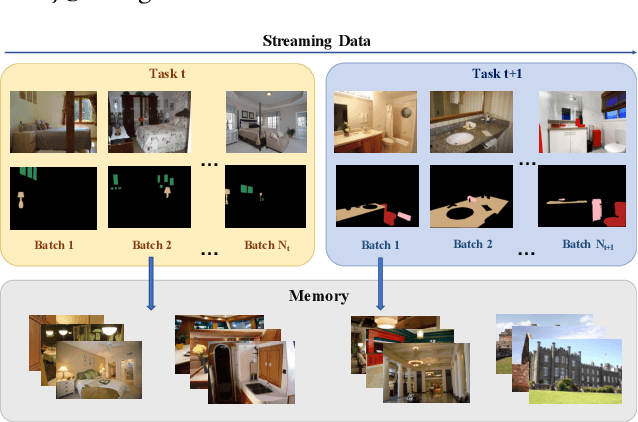


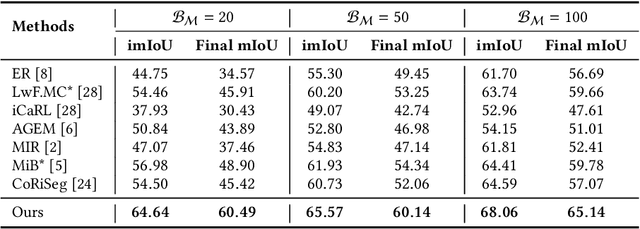
Abstract:Incremental learning of semantic segmentation has emerged as a promising strategy for visual scene interpretation in the open- world setting. However, it remains challenging to acquire novel classes in an online fashion for the segmentation task, mainly due to its continuously-evolving semantic label space, partial pixelwise ground-truth annotations, and constrained data availability. To ad- dress this, we propose an incremental learning strategy that can fast adapt deep segmentation models without catastrophic forgetting, using a streaming input data with pixel annotations on the novel classes only. To this end, we develop a uni ed learning strategy based on the Expectation-Maximization (EM) framework, which integrates an iterative relabeling strategy that lls in the missing labels and a rehearsal-based incremental learning step that balances the stability-plasticity of the model. Moreover, our EM algorithm adopts an adaptive sampling method to select informative train- ing data and a class-balancing training strategy in the incremental model updates, both improving the e cacy of model learning. We validate our approach on the PASCAL VOC 2012 and ADE20K datasets, and the results demonstrate its superior performance over the existing incremental methods.
Learning Implicit Temporal Alignment for Few-shot Video Classification
May 11, 2021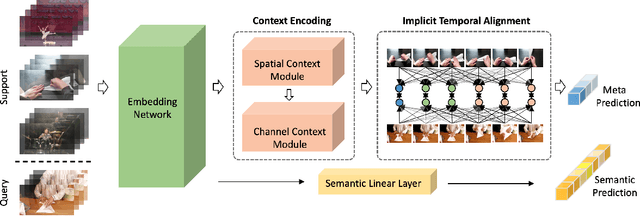
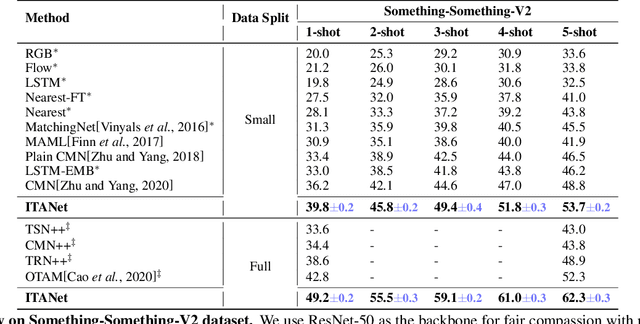
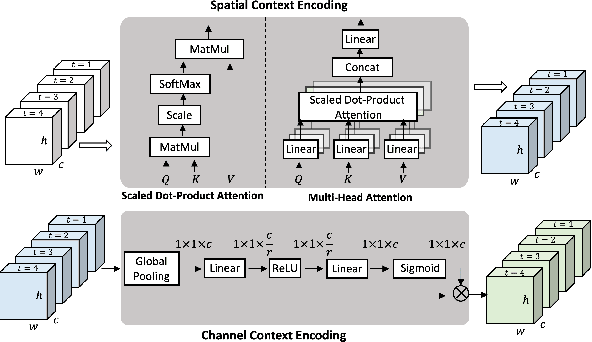
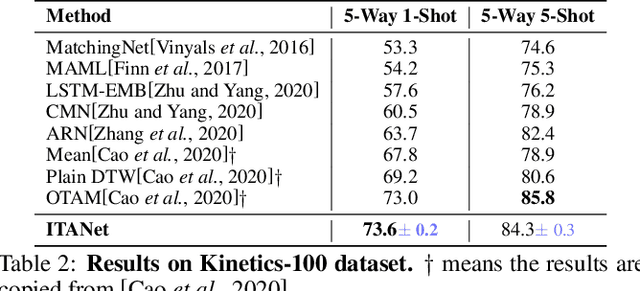
Abstract:Few-shot video classification aims to learn new video categories with only a few labeled examples, alleviating the burden of costly annotation in real-world applications. However, it is particularly challenging to learn a class-invariant spatial-temporal representation in such a setting. To address this, we propose a novel matching-based few-shot learning strategy for video sequences in this work. Our main idea is to introduce an implicit temporal alignment for a video pair, capable of estimating the similarity between them in an accurate and robust manner. Moreover, we design an effective context encoding module to incorporate spatial and feature channel context, resulting in better modeling of intra-class variations. To train our model, we develop a multi-task loss for learning video matching, leading to video features with better generalization. Extensive experimental results on two challenging benchmarks, show that our method outperforms the prior arts with a sizable margin on SomethingSomething-V2 and competitive results on Kinetics.
Learning Context-aware Task Reasoning for Efficient Meta-reinforcement Learning
Mar 03, 2020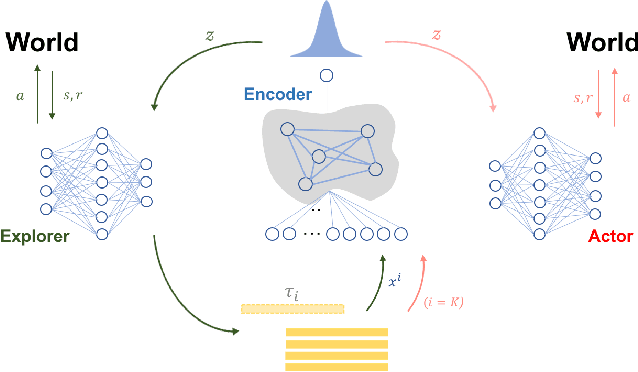



Abstract:Despite recent success of deep network-based Reinforcement Learning (RL), it remains elusive to achieve human-level efficiency in learning novel tasks. While previous efforts attempt to address this challenge using meta-learning strategies, they typically suffer from sampling inefficiency with on-policy RL algorithms or meta-overfitting with off-policy learning. In this work, we propose a novel meta-RL strategy to address those limitations. In particular, we decompose the meta-RL problem into three sub-tasks, task-exploration, task-inference and task-fulfillment, instantiated with two deep network agents and a task encoder. During meta-training, our method learns a task-conditioned actor network for task-fulfillment, an explorer network with a self-supervised reward shaping that encourages task-informative experiences in task-exploration, and a context-aware graph-based task encoder for task inference. We validate our approach with extensive experiments on several public benchmarks and the results show that our algorithm effectively performs exploration for task inference, improves sample efficiency during both training and testing, and mitigates the meta-overfitting problem.
 Add to Chrome
Add to Chrome Add to Firefox
Add to Firefox Add to Edge
Add to Edge